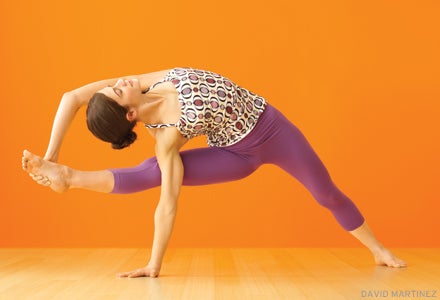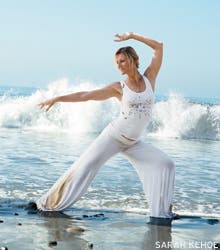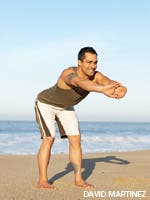Your Flight Plan: 5 Steps to Visvamitrasana

Integrate all of the seemingly disparate parts that make up Visvamitrasana and soar into this incredible pose.
Visvamitrasana (Pose Dedicated to Visvamitra) seems like one of those poses. You know, the ones that seem reserved for an elite group of people whose club you’ll never be a member of. The complexity of the pose can look overwhelming and lead to the illusion that it is inaccessible.
One way to begin your attempt at this challenging pose is to picture a luscious apple tart with caramel sauce and a dollop of homemade vanilla ice cream on top. Admittedly, this is not a common preparation for a yoga posture, but go with it for a moment. If you tasted the dessert at your favorite restaurant, it might seem next to impossible to replicate. But if you followed a recipe for each component and patiently developed your skills at making the crust, then the filling, the sauce, and eventually the ice cream, you’d find that it’s not too difficult. Practice constructing the elements one at a time, and before long they will flow together seamlessly.
The same goes for Visvamitrasana. When you look at it in small increments, you can see it more clearly: The back leg is in a standing pose, the bottom arm is in an arm balance, the torso and top arm are in a sidebend, the abdominals are awake, and the front leg is approaching a split. It’s like that delicious tart with caramel and ice cream on top.
As you learn to practice this pose, remember that it is a combination of simple actions put together in a complex way, just as our complex recipe is a combination of simple ingredients put together skillfully. Instead of letting the big picture overwhelm your mind, you can break the pose down into simple bite-sized portions and work toward a mastery of each.
It would be an exaggeration to say that by practicing the essential components of Visvamitrasana, your body will then ea-sily float into it. But with diligence you will reap some benefits that are even greater than an effortless Visvamitrasana. First, you’ll practice untangling a complex, challenging scenario with poise and equanimity (a lesson you can take off the mat when you become overwhelmed by life’s inevitable complexities). Second, you’ll gain a deeper understanding of your skills and limitations. By practicing this sequence, you might float into Visvamitrasana with skill and grace. Or, you might get a clearer picture of where your obstacles are. You may recognize that your arms are plenty strong, but your hamstrings need some TLC. Or you may discover that your back leg needs to work more strongly in all of your standing poses in order to create greater stability.
Finally, you’ll gain firsthand experience of what it’s like to take seemingly disparate physical actions and integrate them. This sensation of integration—that is, the feeling that everything is coming together, whether you get into the full final pose or not—can be incredibly satisfying. With work, you’ll also get a glimpse of what it’s like to exceed your self-imposed limitations. Your ego will no longer feel that sense of separation that comes with the mistaken notion that there is an exclusive, members-only club that you’re not invited to, in yoga or in life.
5 Steps to Visvamitrasana
Before You Begin
Before you begin this sequence, you’ll want your entire body to be awake and warm. You’ll need plenty of steam to dig into Visvamitrasana, so be careful not to overwork. Practice several Sun Salutations with lunges at a slow, calm pace—indulging in an extra breath or two in each pose. In order to open the legs, you can practice Virabhadrasana II (Warrior Pose II), Utthita Trikonasana (Extended Triangle Pose), and Ardha Chandrasana (Half Moon Pose). Including shoulder openers like Gomukhasana (Cow Face Pose) and Garudasana (Eagle Pose) will also be beneficial.
Watch: A video of this Master Class sequence can be found online here.
Viparita Karani (Legs-up-the-Wall Pose), variation

When you sequence to a challenging pose, it’s tempting to speed up and generate physical intensity as though you were preparing for battle. After all, the body needs to be warm, awake, and supple in order to safely push its edge. But yoga teaches the importance of cultivating relaxation in the midst of difficulty and confusion. As you open your inner thighs and slowly melt away layers of resistance, this wide-stance Viparita Karani will give you a moment to cultivate the relaxation and mindfulness that are essential for maintaining poise and equanimity in the poses to come.
To begin, place a bolster or two folded blankets two to four inches away from a wall. Sit on the prop and place your right hip against the wall. Place your hands on the floor behind you. Slowly swing your legs up the wall and lower your elbows to the floor. Lie all the way back, then scoot your seat as close to the wall as you can without creating discomfort in your legs. The bolster should be underneath the back of your pelvis and lower back, creating a mild backbend. Finish the pose by dropping your legs away from one another until you feel a mild to medium sensation in your inner thighs and groins.
Now that you’re set up, it’s time to let gravity do the heavy work of stretching your legs. Settle, soften, and breathe. Direct your breath to your lower abdomen and inner legs, and place your hands on your hip points. Imagine that your thighbones are releasing toward your outer legs, your hip points are broadening, and your inner thighs are becoming soft and pliable.
As your inner thighs deepen their stretch, shift your attention to your sensory organs—particularly your eyes, ears, and tongue. In Visvamitrasana, these areas will tend to harden and bulge. So take a moment to soften them and allow them to release inward, as if they gently deflate.
Let your mind, body, and breath settle for 5 to 10 minutes in the pose. Allow this pattern of relaxation to imprint itself in your memory, because you’ll need it as the challenging postures start to flow.
Parivrtta Janu Sirsasana (Revolved Head-of-the-Knee Pose)

Visvamitrasana demands that your side body be supple while the rest of your body is firing, stabilizing, and lifting against gravity. To make things even more interesting, the pose throws in a hefty bit of hamstring and inner-thigh intensity. Fortunately, Parivrtta Janu Sirsasana delves into these exact regions, but with less intensity, so you can spend more time learning the actions that will help you in the final pose.
To begin, sit in Baddha Konasana (Bound Angle Pose). Place your fingertips on the floor behind you as you lengthen the sides of your torso. Pause for a moment—retaining the receptive calm of Viparita Karani—and breathe into your lower abdomen. Straighten your right leg to the side about 60 degrees from your pelvis. Glide your left heel deep into your left groin. If this creates discomfort in your knee, you can place your left foot against your right thigh instead.
Now, slide your right hand down your leg to your right ankle. Pull the skin of your ankle toward you and use this leverage to elongate the right side of your ribs toward your right thigh. From there, drop your right forearm to the floor—just inside the shin—and hook your index and middle fingers under your Achilles tendon. Reach your left arm overhead and catch the outer edge of your right foot.
Before deepening specific actions within the pose, simply use your awareness to scan your entire body to become oriented. Although the sensations in your extended leg and top ribs will tend to dominate your attention, cut through these layers and notice your jaw, your back thigh, your bottom ribs, and the contact of your top hand and right foot. Try to experience your whole body in the pose. Be aware of all of the subtle layers of sensation as you continue to take slow, calming breaths.
Now start to shift your attention toward refining the intricacies of the pose. In Visvamitrasana, the torso tends to derotate so that the chest faces the floor. To counteract this tendency, root down through your right thighbone and push your right inner heel farther away from your body. Create a slight pulling action with your right index and middle fingers against your Achilles tendon, and elongate your torso until you are at your maximum stretch without strain. If you are particularly open, your side body will drape over your leg.
Lean back slightly as though you’re going to fall behind your straight leg. Continue to explore the pose as you roll your abdomen, ribs, and chest open. Practice turning from the inside out, encouraging your abdominal organs, kidneys, heart, and lungs to spiral toward the ceiling. Breathe slowly and deeply into any resistance that presents itself. Try to relax any impulse you may have to push your body beyond a comfortable edge.
To complete the pose—and to practice one more element of Visvamitrasana—bend your top elbow toward the ceiling as if you were going to pick your right foot off the floor. If you’re already at your maximum stretch, the elbow won’t actually move, and that’s OK. Gravity will be pressing you down in Visvamitrasana, so it’s important to use the top arm to help lift yourself up.
Take another breath or two; then release your top arm and gently come up out of the pose. Switch sides.
Baddha Parsvakonasana (Bound Side Angle Pose)

In Visvamitrasana, you have two points of contact with the floor—your back foot and your bottom hand. These foundations need to be strong and stable. By practicing Baddha Parsvakonasana, you’ll learn to bring your attention into your back leg, plant your foot, and distribute the weight of your body. In addition, Baddha Parsvakonasana will help prepare your shoulders and outer hips for the demands of the final pose.
Stand sideways on your sticky mat, your feet wide apart. Turn your right foot out, your left foot slightly in. Align your front heel with your back arch. Bend your front knee until your shin is vertical, stepping your left foot back to feel a moderate opening in your inner legs. Place your right fingertips on the floor inside your right foot. Nestle your right shoulder against your right knee, and place your top hand on your top hip.
From there, gently exaggerate the collapse and distortion that typically occur in this pose. Practicing the necessary corrections to common mishaps will help you as the poses become more challenging. To do this, swing your hips to the right, turn your chest and top shoulder toward the ground, and disengage the muscles of your back thigh. Now that you feel what you don’t want to do, cultivate the opposite, optimal pattern: Draw your right sitting bone forward, bring your pelvis into the same plane as your feet, and spiral your chest toward the ceiling. Last, lengthen your back leg and plant the four corners of your back foot.
Continue to the binding phase of the pose by lowering your right shoulder underneath your right knee. Internally rotate your right arm, and slide your fingertips under your right thigh toward the outside of your right hip. Rotate your torso toward the ceiling and wrap your left arm around your back. Clasp your left hand or wrist with your right hand. Use a strap if you’re not able to bind. It’s time to redouble your efforts to cultivate buoyancy rather than succumbing to collapse. Charge your back leg and root your back foot into the sticky mat. Firm the inner border of your back thigh and lift your hips slightly. Engage your lower abdominals and pelvic floor. Feel how these actions take weight off your front leg and distribute the effort of your body more evenly. Breathe slowly and deeply, knowing that the grounding and lifting of your back leg and pelvis are not only instrumental for a healthy Baddha Parsvakonasana, but are also essential elements of Visvamitrasana.
Vasisthasana (Side Plank Pose), variation

You’ve cultivated relaxation in Viparita Karani, opened your side body and legs in Parivrtta Janu Sirsasana, and practiced grounding your back leg while lifting your pelvis in Baddha Parsvakonasana. Yet there’s still a big piece of the puzzle to practice: Visvamitrasana is an arm balance. Despite the bells and whistles of Visvamitrasana, the arm-balancing component is built from the fairly simple and accessible template of Vasisthasana.
The alignment of Vasisthasana may look simple, but the actions of the bottom shoulder are complex. These actions become particularly important in Visvamitrasana, where tightness in the top leg and hip can cause the front leg to press against the bottom shoulder and arm, forcing the shoulder out of optimal alignment (and potentially out of joint). When you practice Vasisthasana, focus on proper arm bone placement and scapular stabilization. This will teach you the desired pattern for the final pose and will also help strengthen and integrate your torso, arms, and shoulders.
Come into Plank Pose and stack your shoulders directly over your wrists. Root down through the bases of your fingers, and rotate your elbow creases and biceps forward. This should externally rotate your arm bones. Rather than collapsing your chest toward the floor, gently lift the back of your heart and lungs. Notice how this lifting action broadens your shoulder blades and activates your arms more thoroughly. Maintaining the rotation of your arms and the broadness of your shoulder blades, shift into Adho Mukha Svanasana (Downward-Facing Dog Pose). As you rest in Downward Dog for four to five breaths, remember the actions you just practiced in your arms and shoulders—you’ll need to make similar movements in Vasisthasana and Visvamitrasana.
To move into Vasisthasana, rock forward to Plank Pose, root the base of your fingers, and gently rotate your elbow creases and biceps forward. Broaden your upper back and press your sticky mat strongly into the floor. Come to the outer edge of your right foot, stack your left leg on top of your right leg, and place your left hand on your left hip. You’ve got the basic shape. Now, it’s time to go into detail with your shoulders.
First, look down at your right hand, and press the base of your index finger into the floor. Continue the external rotation of your bottom arm that you initiated in Plank. Notice how this external rotation draws the head of your upper arm bone into the joint and broadens the bottom collarbone. Now support this alignment by drawing your right shoulder blade down your back. As this shoulder blade draws into place, firm it against the back of your ribs. This work of supporting your weight with your bottom arm may be challenging, but your arm and shoulder should feel stable.
Finish this variation by reaching your top arm and lifting your hips strongly toward the ceiling. In fact, lift your outer legs, hips, and ribs so completely that your whole body begins to arc into a sidebend. Deepen this arc by extending your top arm over your ear toward the front edge of your mat, palm facing down. Allow your top ribs to round toward the ceiling—-fanning into a sidebend—as you lift.
Take 5 to 10 breaths in the pose before lowering your top hand to the floor and returning to Downward-Facing Dog.
Visvamitrasana (Pose Dedicated to Visvamitra)

Before dicing the first onion in preparation for dinner service, a chef organizes the essential ingredients and cookware in the station so that the work flows with natural efficiency. In this sequence you’ve done something akin to the chef’s protocol: You’ve organized the actions and the postural and energetic ingredients of Visvamitrasana so that you can develop the pose with maximum efficiency, ease, and awareness. You’ve had your dinner; now it’s time for dessert.
To begin, take a wide stride, turn your right foot toward the front of your mat, and turn your back foot slightly in. Bend your front knee, and press your right shoulder against your inner right knee. Take a few breaths, slowly rocking your pelvis forward and backward to soften the muscular resistance in your hips. Drop your right shoulder underneath your front knee, sneak your right arm behind your shin, and place your right hand outside your foot. Pause for a moment and feel your three points of contact with the floor: your right hand, front foot, and back foot. Charge your back leg and shift your weight slightly to the right and into your right arm. Take a slow, steady breath, and remember the calm of Viparita Karani—you’re about to take flight.
To lift off, hold your front foot with your left hand. Lean onto your right hand until your front foot lifts off the ground. Extend your right leg straight, squeezing your inner thigh against your arm in order to keep it from slipping toward the ground. The pressure of the leg against the bottom arm will tend to force your bottom shoulder forward and down. To counteract this, remember the actions of Vasisthasana: Root down through the base of all your fingers, gently externally rotate your arm so the elbow crease and biceps turn toward the front of your mat, and draw your shoulder blade down your back. Complement this stability by working your back leg strongly, as though you were doing a standing pose. To finish the pose, shift your focus to the sidebend. Bend your top elbow toward the ceiling, and roll your chest open. Breathe into the spacious opening of your top ribs.
After several breaths in the pose, bend your front knee, lower your foot back to the floor, and pause to savor your experience. Then transition to your second side.
It is inevitable, normal, and (arguably) desirable to experience a wide array of thoughts, feelings, and sensations when practicing poses like Visvamitrasana—from the excitement of skillful execution and expansion, to the frustration of failing to take off, to the embarrassment of—taking off and immediately ending up on your can. Give yourself permission to feel your experience honestly and learn about your body and mind in the process. Remember that practicing Visvamitrasana involves not only the actions of the muscles and the organization of the bones, but also the deep awareness that comes from stepping into a complex, difficult situation and maintaining ease, composure, and a feeling of curiosity.
To finish your practice, do a few quieting, symmetrical forward bends like Upavistha Konasana (Wide-Angle Seated Forward Bend), Baddha Konasana, and Paschimottanasana(Seated Forward Bend). Allow yourself to move slowly and savor the effects of this practice as you transition into Savasana (Corpse Pose).
ABOUT OUR EXPERT
Jason Crandell teaches alignment-based vinyasa yoga in San Francisco and beyond.